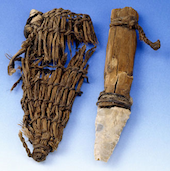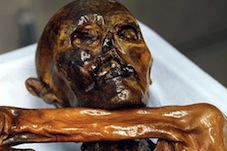About 5300 years ago, a man died on a remote mountain pass in the Alps. In 1991, the glacier that had kept him frozen for so long melted, revealing his well-preserved corpse. The body of this "Iceman," along with his clothes, tools, and other artifacts, has provided an amazing amount of information about his society, daily life, and the circumstances of his death.
Some of the most interesting evidence found with Iceman comes from plant material. He had a storage container made from birch bark and a wooden bow and quiver of arrows. Scientists also found several species of tree pollen inside Iceman's digestive tract, which he most likely ingested when the airborne pollen settled on his food. Scientists extracted high levels of chlorophyll from the maple leaves found with Iceman. Could this evidence be used to determine the season of his death?
What might these and other botanical clues reveal about Iceman? Look for answers to these questions and other clues in the chapter to help you solve the mystery of Iceman.



